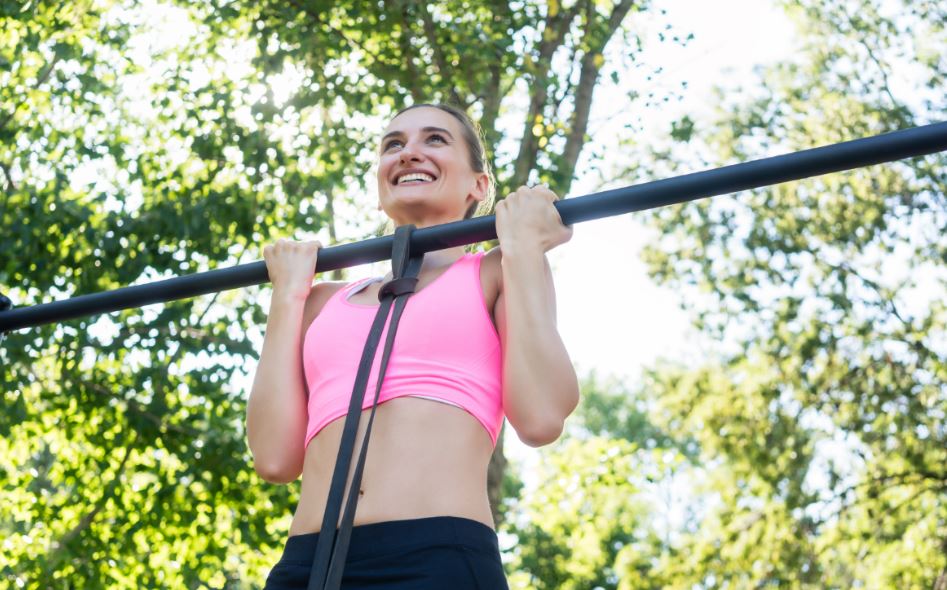Pull-Ups: Are You Up For The Challenge?

One of the best ways to exercise and strengthen your arm and back muscles is to do pull-ups. Although it is considered a demanding exercise, pull-ups allow you to completely work your entire body. Great results can be seen immediately, and all you need to do is practice.
So, what do pull-ups consist of? What benefits do you get from doing this exercise? What things should be taken into account? See all of these answers below.
What are pull-ups?
This type of training involves grabbing a bar and lifting the weight of your own body up to the height of your chin. Through this exercise, you will work the muscles in your arms, forearms, back, and abdomen.
Pull-ups are bodyweight exercises, that is, they do not require free weights or machines because your own weight provides resistance against gravity. Therefore, it takes practice to lift your weight. It is a complete practice, because through different grips, it is possible to strengthen all the muscles in the upper body.

Types of pull-ups
Pull-ups can seem monotonous. But in reality, this is not true; there are exercises that vary according to the type of grip on the bar and you can create various pull-up programs.
Each type of pull-up is done by changing the way you grip the bar and by working a different muscle. Therefore, it is important to know and try each of the grips in order to choose the right one for you, and according to the muscles that you wish to strengthen.
- Supine Pull-Up: This type of pull-up is the least difficult and the best for beginners. It is done by holding the bar with your hands facing inwards. Through this exercise, your biceps are worked.
- Prone Grip Pull-Up: This pull-up is bit more difficult, and is done by gripping the bar with your hands facing outwards. The degree of difficulty increases depending on where you place your thumbs– either above or below the bar.
- Neutral Pull-Up: The palms of your hands should be facing each other. Coaches recommend this exercise to start, since the risk of injury is low.
Another thing to consider is the grip width. Your muscles work with less or more force depending on the distance between your hands, in relation to your shoulders.
The greater the width of the grip, the less muscle strength is needed to complete a pull-up. As the technique is learned and your arms are strengthened, this width should be reduced.
Pull-Up Challenge: Benefits and Recommendations
Pull-ups can generate some hesitation for the athlete, but if you think about the benefits you can obtain by completing them, you will soon forget your fear.
You must remember that this exercise involves around 15 muscles located in your chest, torso, and abdominals, with the latissimus dorsi being the muscle that is worked the most.
This activity helps to strengthen your back and arms, which can become rigid as a result of a sedentary lifestyle. In addition, you will receive four main benefits:
- Strength: when you lift your own body weight, you generate an increase in the strength and proportion of your muscles.
- Posture: the technique that is used to complete a pull-up correctly helps to improve the posture of your spine. Through this, you can reduce pain in your upper and lower back as your vertebrae are aligned and your arms will be able to rise vertically in their entirety.
- Figure: pull-ups tone the muscles in your back, which is rarely taken into account. Your abdominals are also worked. Thus, your figure is toned and and your muscles are molded.
- Time: when you do not have time for an extensive exercise session, pull-ups are ideal. With only 50 repetitions, you can work your entire body.

The necessary progression
Doing pull-ups is a challenge that should be practiced progressively, taking into account the following recommendations to avoid injury:
- This exercise demands real effort. In order to have enough energy and perform well, you need to control your weight with a proper diet.
- Before beginning the pull-ups, warm up your muscles in order to avoid injury and to achieve optimal performance.
- Choose the correct bar to use. It should be well supported, stable, and not too thin–so that you can grip it correctly.
- Be consistent with this exercise, although you may not see significant progress at the beginning. It is necessary to vary the types of grip and increase your repetitions at each session. This will help to improve the strength of the different muscles until you completely master the pull-up routine.
One of the best ways to exercise and strengthen your arm and back muscles is to do pull-ups. Although it is considered a demanding exercise, pull-ups allow you to completely work your entire body. Great results can be seen immediately, and all you need to do is practice.
So, what do pull-ups consist of? What benefits do you get from doing this exercise? What things should be taken into account? See all of these answers below.
What are pull-ups?
This type of training involves grabbing a bar and lifting the weight of your own body up to the height of your chin. Through this exercise, you will work the muscles in your arms, forearms, back, and abdomen.
Pull-ups are bodyweight exercises, that is, they do not require free weights or machines because your own weight provides resistance against gravity. Therefore, it takes practice to lift your weight. It is a complete practice, because through different grips, it is possible to strengthen all the muscles in the upper body.

Types of pull-ups
Pull-ups can seem monotonous. But in reality, this is not true; there are exercises that vary according to the type of grip on the bar and you can create various pull-up programs.
Each type of pull-up is done by changing the way you grip the bar and by working a different muscle. Therefore, it is important to know and try each of the grips in order to choose the right one for you, and according to the muscles that you wish to strengthen.
- Supine Pull-Up: This type of pull-up is the least difficult and the best for beginners. It is done by holding the bar with your hands facing inwards. Through this exercise, your biceps are worked.
- Prone Grip Pull-Up: This pull-up is bit more difficult, and is done by gripping the bar with your hands facing outwards. The degree of difficulty increases depending on where you place your thumbs– either above or below the bar.
- Neutral Pull-Up: The palms of your hands should be facing each other. Coaches recommend this exercise to start, since the risk of injury is low.
Another thing to consider is the grip width. Your muscles work with less or more force depending on the distance between your hands, in relation to your shoulders.
The greater the width of the grip, the less muscle strength is needed to complete a pull-up. As the technique is learned and your arms are strengthened, this width should be reduced.
Pull-Up Challenge: Benefits and Recommendations
Pull-ups can generate some hesitation for the athlete, but if you think about the benefits you can obtain by completing them, you will soon forget your fear.
You must remember that this exercise involves around 15 muscles located in your chest, torso, and abdominals, with the latissimus dorsi being the muscle that is worked the most.
This activity helps to strengthen your back and arms, which can become rigid as a result of a sedentary lifestyle. In addition, you will receive four main benefits:
- Strength: when you lift your own body weight, you generate an increase in the strength and proportion of your muscles.
- Posture: the technique that is used to complete a pull-up correctly helps to improve the posture of your spine. Through this, you can reduce pain in your upper and lower back as your vertebrae are aligned and your arms will be able to rise vertically in their entirety.
- Figure: pull-ups tone the muscles in your back, which is rarely taken into account. Your abdominals are also worked. Thus, your figure is toned and and your muscles are molded.
- Time: when you do not have time for an extensive exercise session, pull-ups are ideal. With only 50 repetitions, you can work your entire body.

The necessary progression
Doing pull-ups is a challenge that should be practiced progressively, taking into account the following recommendations to avoid injury:
- This exercise demands real effort. In order to have enough energy and perform well, you need to control your weight with a proper diet.
- Before beginning the pull-ups, warm up your muscles in order to avoid injury and to achieve optimal performance.
- Choose the correct bar to use. It should be well supported, stable, and not too thin–so that you can grip it correctly.
- Be consistent with this exercise, although you may not see significant progress at the beginning. It is necessary to vary the types of grip and increase your repetitions at each session. This will help to improve the strength of the different muscles until you completely master the pull-up routine.
This text is provided for informational purposes only and does not replace consultation with a professional. If in doubt, consult your specialist.








